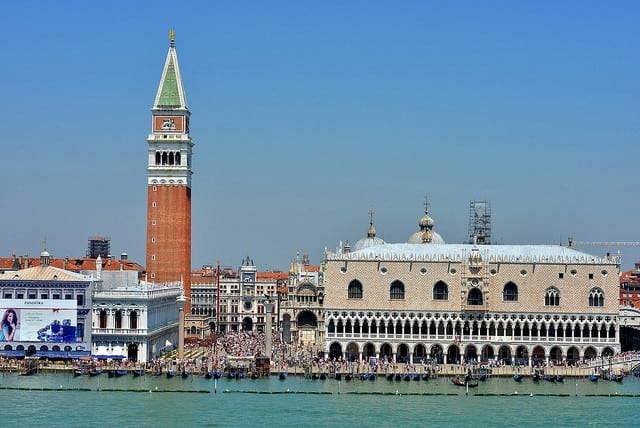Located in the Piazza San Marco, St. Mark’s Basilica & Campanile is the renowned bell tower of St Mark’s Basilica. Its initial construction began on pre-existing Roman foundations in the 9th century, which historians claim was meant to serve the purpose of a lighthouse. Throughout the centuries, it was rebuilt a number of times between the 12th and 14th centuries. St. Mark’s Basilica & Campanile, as we known it today, took on its definitive appearance between 1511 and 1514.
The structure of St. Mark’s Basilica & Campanile represents a harmony of line and proportions typical of Roman architecture. The building of St. Mark’s Basilica & Campanile is a plain bricked structure, topped by an arched belfry that houses five bells, each with a separate function. The Renghiera announced executions, the Mezza Terza proclaimed a session of the Senate, the Nona sounded midday and the Trottiera called the members of the Maggior Consiglio. The Marangona, the biggest bell of the lot, rang to mark the beginning and ending of a working day.
Perched on the belfry is another brick section decorated with walking lions, in honor of St. Mark. There is also a pyramidal spire on top of the bell tower in the form of the angel Gabriel. At the base of the tower is the
Logetta, an ornate podium added in 1540. Venice’s largest bell tower has been the inspiration for several other towers across Europe and North America. Metlife Tower in New York, Sather Tower in Berkeley and Venetian Towers at the Plaça d’Espanya in Barcelona are some other structures which have drawn inspiration from St. Mark’s Basilica & Campanile.
In 1902, the decision to renovate St. Mark’s Basilica & Campanile was taken. The new campanile was inaugurated on April 25, 1912, on the occasion of Saint Mark’s feast day. Incidentally, this happened to be exactly 1000 years after the foundations of the original building were laid.
In order to access St. Mark’s Basilica & Campanile, the best option for tourists is to access Venice via flight first and foremost. Once you reach Venice, then there is the option of either hiring a taxi or using the public transport of Venice to access St. Mark’s Basilica & Campanile, which is located in the Piazza San Marco.
An important attraction of St. Mark’s Basilica & Campanile, is the spectacular view over the city of the Doges and the Grand Canal, which it provides. The tower was equipped with an elevator in the 1960s and it takes eight euros to go up via elevator. Since the elevator holds a limited number of people and in order to avoid the crowd, it is recommended that you visit St. Mark’s Basilica & Campanile either early in the morning or late in the evening.
Late spring and early summer are the best times to visit Venice as far as weather is concerned. This is because between September and November, Venice empties out, resulting in reasonable hotel rates. The months between March and May is another excellent period to visit Venice due to the brilliant weather. Between June and August, when Venice witnesses summers, the city is jam packed with tourists. So it is highly recommended that you avoid these months when planning a visit to St. Mark’s Basilica & Campanile.
So plan a trip to Venice to explore this architectural marvel called St. Mark’s Basilica & Campanile!













